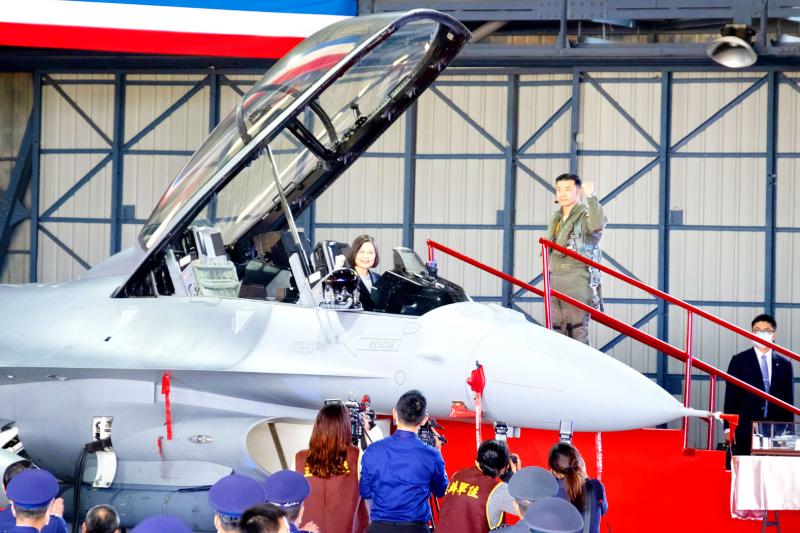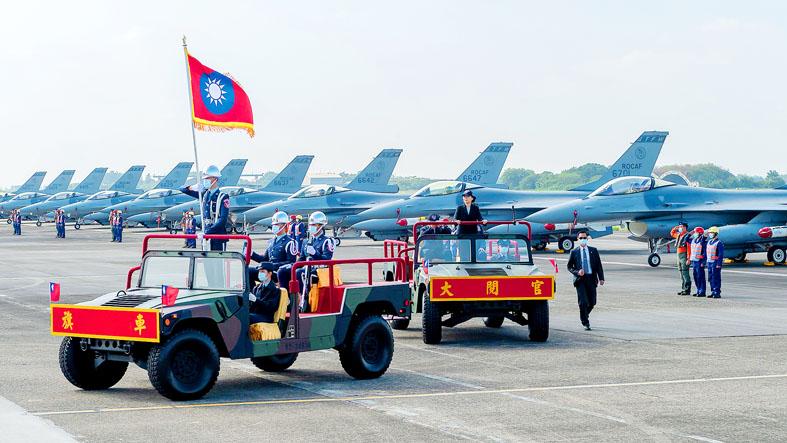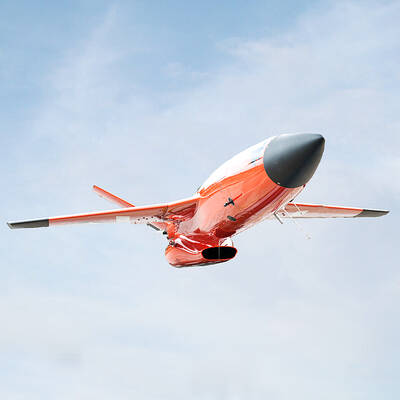President Tsai Ing-wen (蔡英文) yesterday said that three air force squadrons being commissioned and equipped with upgraded F-16s would enhance Taiwan’s modern warfare capabilities, describing it as a testament to the nation’s solid partnership with the US.
Tsai made the remarks at a commissioning ceremony for three F-16 combat squadrons in the 4th Tactical Fighter Wing based at the Chiayi Air Base.
The ceremony marked a new chapter in the history of the air force, a chapter significant in terms of Taipei’s relationship with Washington and the quality of the nation’s aerospace technology, Tsai said.

Photo: Johnson Lai, AP
With help from US-based Lockheed Martin Corp, the armed forces and state-owned Aerospace Industrial Development Corp (漢翔航空) launched a program in 2016 to upgrade Taiwan’s F-16A/Bs to F-16Vs by equipping them with more advanced avionics and electronic warfare systems.
This cooperation between Taiwan and the US defense industry is further proof of how the two nations’ friendship has advanced and a testimony to solid promises made by close partners, Tsai added.
“As long as we continue to uphold the shared values of democracy and freedom, more like-minded countries will definitely join and stand with us along the same line,” Tsai said, adding that the upgraded jets also signified a major step forward for the domestic defense industry.

Photo: Reuters via the Presidential Office
More importantly, the enhanced stealth and long-range sensors of the F-16Vs would boost their combat capabilities in modern warfare settings, she said.
All of the nation’s F-16A/Bs are to be upgraded with more advanced avionics, including APG-83 Scalable Agile Beam Radar, a helmet-mounted cueing system, and other flight management and electronic warfare systems.
On Wednesday, the air force said that 64 of the nation’s 141 F-16A/B jets have been upgraded to the new F-16V standards.
At yesterday’s commissioning ceremony, more than 15 fighter jets took part in aerial maneuvers, flying in formation, while an F-16V demonstration was held to highlight the upgraded fighter jets’ capabilities.
The nation’s Thunder Tigers aerobatic team also put on a performance to celebrate the occasion.
On the ground, the air force loaded 12 F-16Vs with AIM-120 advanced medium-range air-to-air missiles, AIM-9 Sidewinder short-range air-to-air missiles and GBU-10 Paveway high-explosive laser-guided bombs to showcase the fighter jets’ combat capabilities.

CROSS-STRAIT COLLABORATION: The new KMT chairwoman expressed interest in meeting the Chinese president from the start, but she’ll have to pay to get in Beijing allegedly agreed to let Chinese Nationalist Party (KMT) Chairwoman Cheng Li-wun (鄭麗文) meet with Chinese President Xi Jinping (習近平) around the Lunar New Year holiday next year on three conditions, including that the KMT block Taiwan’s arms purchases, a source said yesterday. Cheng has expressed interest in meeting Xi since she won the KMT’s chairmanship election in October. A source, speaking on condition of anonymity, said a consensus on a meeting was allegedly reached after two KMT vice chairmen visited China’s Taiwan Affairs Office Director Song Tao (宋濤) in China last month. Beijing allegedly gave the KMT three conditions it had to

STAYING ALERT: China this week deployed its largest maritime show of force to date in the region, prompting concern in Taipei and Tokyo, which Beijing has brushed off Deterring conflict over Taiwan is a priority, the White House said in its National Security Strategy published yesterday, which also called on Japan and South Korea to increase their defense spending to help protect the first island chain. Taiwan is strategically positioned between Northeast and Southeast Asia, and provides direct access to the second island chain, with one-third of global shipping passing through the South China Sea, the report said. Given the implications for the US economy, along with Taiwan’s dominance in semiconductors, “deterring a conflict over Taiwan, ideally by preserving military overmatch, is a priority,” it said. However, the strategy also reiterated

‘BALANCE OF POWER’: Hegseth said that the US did not want to ‘strangle’ China, but to ensure that none of Washington’s allies would be vulnerable to military aggression Washington has no intention of changing the “status quo” in the Taiwan Strait, US Secretary of Defense Pete Hegseth said on Saturday, adding that one of the US military’s main priorities is to deter China “through strength, not through confrontation.” Speaking at the annual Reagan National Defense Forum in Simi Valley, California, Hegseth outlined the US Department of Defense’s priorities under US President Donald Trump. “First, defending the US homeland and our hemisphere. Second, deterring China through strength, not confrontation. Third, increased burden sharing for us, allies and partners. And fourth, supercharging the US defense industrial base,” he said. US-China relations under

The Chien Feng IV (勁蜂, Mighty Hornet) loitering munition is on track to enter flight tests next month in connection with potential adoption by Taiwanese and US armed forces, a government source said yesterday. The kamikaze drone, which boasts a range of 1,000km, debuted at the Taipei Aerospace and Defense Technology Exhibition in September, the official said on condition of anonymity. The Chungshan Institute of Science and Technology and US-based Kratos Defense jointly developed the platform by leveraging the engine and airframe of the latter’s MQM-178 Firejet target drone, they said. The uncrewed aerial vehicle is designed to utilize an artificial intelligence computer